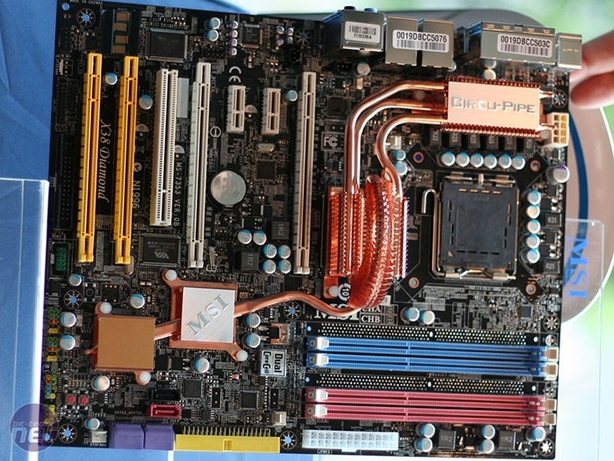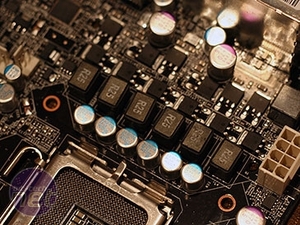
The extra two yellow PCI-Express slots are controlled by a 16 lane IDT PCI-Express switch. It's PCI-Express 1.1 only, so will actually downgrade the white x16 ports from 2.0 to 1.1 when something is plugged into either yellow port. There seems to be some confusion about whether this chip actually provides two x8 or x4 lanes, as the product information isn't exactly clear for just two devices.
After discussing it with MSI, it seems the company might possibly use a different chip on mass production boards that's specifically tailored for this boards use - this will change the two x16s into four x8s from the northbridge. MSI has done this as an alternative to the AMD RD790 chipset which will offer quad graphics card support, so at least now both high end Intel and AMD solutions will have an equal base for the consumer to decide upon.
Other board features include six SATA 3Gbps ports, two of which are controlled by a Silicon Image "hardware RAID" chipset which automatically sets up a RAID 1 array when two disks are inserted.
Despite the fact this will likely prove a better product than the infamous JMicron chipset, the SI chipset unfortunately doesn't have a parallel port on-board so MSI has to use up yet another PCI-Express x1 lane for just an IDE port. Thankfully the southbridge has six x1 lanes, so you're not really missing out on any extra motherboard slot or feature because of it.

Annoyingly, again, MSI chose to sacrifice two of the on-board native six SATA ports for eSATA duties. We tried explaining this waste to MSI and while the marketing people took my criticisms on board, they also considered it a feature advantage. You can use the Intel Matrix RAID technology to have external drives included in a RAID 1 array for example, or possibly use the port multiplier function for an array of drives from a single port.
However, I'm sure you'll agree - most people would prefer a separate controller for one or two eSATA ports as the vast majority of you will preferentially use the internal SATA. As it is hard-wired, there's no option for the 99 percent of us that just want another few ports inside instead. Come to think of it, I actually don't even know of any consumer products that use the port multiplier option with eSATA, making this even less useful.
Finally the power regulation is a dual-channel, four-phase solution, where there are two mosfets per choke and two sets of these per "channel". This balances out the power draw between them, alleviating the overall stress and extreme temperature gradients that can occur from using four cores all with different loadings. They aren't special mosfets or chokes though (again compared to Gigabyte), and MSI still hasn't delved into the world of digital PWMs yet.
On a slightly different note, we did ask about MSI's RD790 motherboard, but there's currently no word on it just yet. This is both surprising and slightly worrying - we can only assume that it's because Phenom parts are still a little way away, and so we'll know more when you can buy the CPUs for it.
After discussing it with MSI, it seems the company might possibly use a different chip on mass production boards that's specifically tailored for this boards use - this will change the two x16s into four x8s from the northbridge. MSI has done this as an alternative to the AMD RD790 chipset which will offer quad graphics card support, so at least now both high end Intel and AMD solutions will have an equal base for the consumer to decide upon.
Other board features include six SATA 3Gbps ports, two of which are controlled by a Silicon Image "hardware RAID" chipset which automatically sets up a RAID 1 array when two disks are inserted.
Despite the fact this will likely prove a better product than the infamous JMicron chipset, the SI chipset unfortunately doesn't have a parallel port on-board so MSI has to use up yet another PCI-Express x1 lane for just an IDE port. Thankfully the southbridge has six x1 lanes, so you're not really missing out on any extra motherboard slot or feature because of it.

Annoyingly, again, MSI chose to sacrifice two of the on-board native six SATA ports for eSATA duties. We tried explaining this waste to MSI and while the marketing people took my criticisms on board, they also considered it a feature advantage. You can use the Intel Matrix RAID technology to have external drives included in a RAID 1 array for example, or possibly use the port multiplier function for an array of drives from a single port.
However, I'm sure you'll agree - most people would prefer a separate controller for one or two eSATA ports as the vast majority of you will preferentially use the internal SATA. As it is hard-wired, there's no option for the 99 percent of us that just want another few ports inside instead. Come to think of it, I actually don't even know of any consumer products that use the port multiplier option with eSATA, making this even less useful.
Finally the power regulation is a dual-channel, four-phase solution, where there are two mosfets per choke and two sets of these per "channel". This balances out the power draw between them, alleviating the overall stress and extreme temperature gradients that can occur from using four cores all with different loadings. They aren't special mosfets or chokes though (again compared to Gigabyte), and MSI still hasn't delved into the world of digital PWMs yet.
Early thoughts...
Overall, the board has better features than usual which is always good, however it just feels a touch sporadic and there isn't that elegance in the design. I know, if it works then what the hell, right? But for example, dedicating a whole PCI-Express x1 lane for just one IDE port feels... wrong. MSI is limited by the options of chipsets available, true, but it seems like there's just been a check list and stuff has been progressively thrown on then the dots have been joined.On a slightly different note, we did ask about MSI's RD790 motherboard, but there's currently no word on it just yet. This is both surprising and slightly worrying - we can only assume that it's because Phenom parts are still a little way away, and so we'll know more when you can buy the CPUs for it.

MSI MPG Velox 100R Chassis Review
October 14 2021 | 15:04










Want to comment? Please log in.